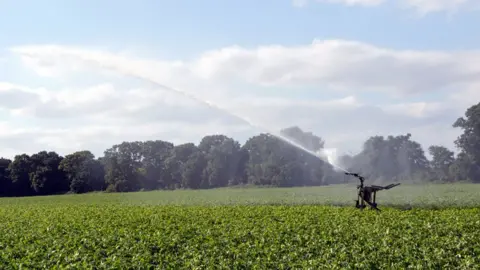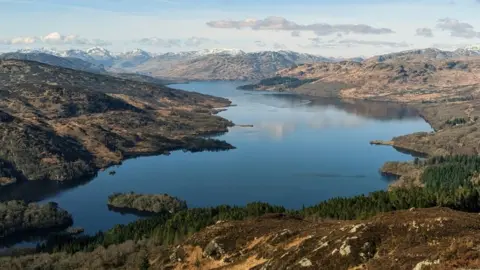Why is a wet country like Scotland facing water scarcity?
 BBC
BBCScotland's weather has a reputation for being wet, damp, drookit. While the south of England faces a summer hosepipe ban, Scottish households rarely have this worry.
But 2022 has brought a series of water scarcity warnings from the Scottish Environment Protection Agency, suggesting a wake-up call may be needed north of the border. Sepa's latest report found the situation was becoming increasingly worrying in the east of Scotland.
While there are no plans for water restrictions for Scottish homes, it is not just about keeping gardens growing. Sepa says this is a result of climate change, and it could have a serious impact on agriculture and businesses in Scotland.

How scarce is water in Scotland?

In 2022, the east of Scotland experienced its driest January since 1940. This was followed by lower-than-average spring and summer rainfall. Sepa has warned that parts of Fife have now reached the highest level for water scarcity.
Other parts of the country have been told to brace for similar conditions. Last month the Tweed area, the Ythan, Dee and Don areas, and the Firth of Forth, Firth of Tay and the Almond and Tyne were graded at moderate scarcity.
Scottish Water says Scotland's reservoir storage levels are at 81% - around average for this time of year.
But in eastern and southern areas some reservoirs are being topped up from alternative water sources to ensure supplies don't run out for local homes.
Scottish Water says it is working to maintain public water supply to customers in parts of the country affected by the prolonged dry warm summer weather.
What happens if water becomes too scarce?
 Getty Images
Getty ImagesSepa is responsible for managing Scotland's natural water resources. It issues "abstraction" licences to businesses that need to take large amounts for agriculture and other industrial uses.
Abstraction is the process of taking water from a natural source such as a river, burn, loch or underground supply. This can be taken through pumps, pipes, wells, boreholes or other methods.
If water becomes too scarce Sepa has the power to suspend water abstraction licences, if necessary, to protect the environment. This mean businesses won't be able to take the supplies they usually do.
Sepa's Head of Water and Planning, Nathan Critchlow-Watton, says climate change means water scarcity will become "even more frequent".
"We want to work with businesses to plan their water usage long term, so that we can preserve this vital resource as effectively as possible," he says.
"Not only will that protect Scotland's rivers and lochs, but it will minimise business risks as well."
How do Scotland's water warnings work?
As part of Sepa's responsibility for forecasting and monitoring water resources, it produces a regular water scarcity report in the summer months from May to September.
Scotland's natural water levels are categorised into five grades - with necessary advice for businesses at each alert level.
- Normal - Water can be taken from sources as usual.
- Early warning - Industries should consider how they can use water more efficiently.
- Alert - Industries irrigating land should check equipment, not overspray and irrigate at night to avoid evaporation.
- Moderate scarcity - Industries should reduce the amount of water they take, stagger use with others nearby or switch to other supplies.
- Significant scarcity - Water resources are becoming scarce. Industries should switch supplies or stop taking water altogether.
Why is the east of Scotland worst hit?

Scotland rightly has a reputation as a wet country, but Sepa water resources specialist Michael Wann points out that rain doesn't always fall "in the right place at the right time".
Scotland has experienced a number of recent dry years. And with climate change, Sepa says this will become more frequent and more severe in years ahead.
There is also an east-west split, with the east of the country recording at least six out of the last eight months with below average rainfall. The west coast benefits from more frequent rain.
But there's no room for complacency wherever you live.
Mr Wann says: "Because these events are becoming more frequent and more common, we are expecting summers in Scotland to be much drier"
Which businesses need natural water sources?
 Getty Images
Getty ImagesWater is a vital resource for many rural industries in Scotland. There's farming, hydropower and whisky production. Even golf clubs rely on natural sources to keep their fairways green.
For the production of whisky, distilleries need supplies of clean water. Along with malted barley and yeast, water is one of the three essential ingredients required in the distilling process.
But it's farming where it is most essential for irrigation, livestock watering and crop spraying.
Irrigation represents the most intensive use of water by agriculture. It can also have the most significant impact on water levels, as it happens at the time of year when water is scarcest.
Much of the irrigation in Scotland is for potatoes, with the main areas in the east coast of Scotland. Exactly the area suffering the most from reduced rainfall.
NFU Scotland's Environmental Resources Policy Manager, Sarah Cowie, says: "Water is a vital resource for the agriculture sector as we cannot produce food without a consistent and plentiful water supply.
"With significant areas of Scotland experiencing a prolonged dry spell, it's important farmers take steps to ensure the continued supply of water and avoid disruption."
What does water scarcity mean for homes?
 Getty Images
Getty ImagesWhile Sepa works to monitor the country's water environment, it is Scottish Water that is responsible for supplying water and waste services to homes and businesses.
Scottish Water says there are no plans to apply restrictions such as hosepipe bans in Scotland, but it is urging people to use water as efficiently as possible.
It says that in a water scarcity situation people can take shorter showers, turn off the tap while brushing teeth, use washing machines and dishwashers only when fully loaded, swap the garden hose for a watering can and wash cars with a sponge.
Peter Farrer, Scottish Water's Chief Operating Officer, says: "Public water supply supports daily life around the clock and our national reservoir storage remains at a level where we can continue to meet requirements.
"We have seen water demand peaks, particularly around hot weekends, and customers can play an important role in how we manage our country's water resources."
